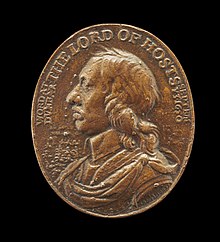| Revision as of 11:09, 3 January 2025 editTheBestEditorInEngland (talk | contribs)Extended confirmed users2,801 editsNo edit summary← Previous edit | Revision as of 14:56, 3 January 2025 edit undoEwhite31 (talk | contribs)Extended confirmed users, New page reviewers1,578 edits added further citations and removed single source tagTag: Visual editNext edit → | ||
| Line 1: | Line 1: | ||
| {{one source|date=January 2025}} | |||
| {{short description|Campaign medal awarded for participation in the 1650 Battle of Dunbar}} | {{short description|Campaign medal awarded for participation in the 1650 Battle of Dunbar}} | ||
| {{Use British English|date=February 2021}} | {{Use British English|date=February 2021}} | ||
| Line 5: | Line 4: | ||
| {{Infobox military award | {{Infobox military award | ||
| |name = Dunbar Medal |
|name = Dunbar Medal | ||
| |image = Battle of Dunbar medal.jpg | |image = Battle of Dunbar medal.jpg | ||
| |image_size = 150px | |image_size = 150px | ||
| Line 33: | Line 32: | ||
| }} | }} | ||
| The '''Dunbar Medal''' is a ] of the ] and was sanctioned by Parliament in 1650 to be awarded to officers and other ranks of the ] who participated in the ] on 3 September 1650. Two versions were produced; one in gold for officers, and one in silver for other ranks. The Dunbar Medal is thought by historians and ]s to be the first ever military medal to be eligible to every man present in a campaign or engagement, irrespective of rank. It was worn by a cord or chain around the neck.<ref name= |
The '''Dunbar Medal''' is a ] of the ] and was sanctioned by Parliament in 1650 to be awarded to officers and other ranks of the ] who participated in the ] on 3 September 1650.<ref name=":0">{{Cite journal |date=1869 |title=The Oldest English War Medal |url=https://www.jstor.org/stable/43586995 |journal=American Journal of Numismatics, and Bulletin of the American Numismatic and Archaeological Society |volume=4 |issue=8 |pages=59–60 |issn=2381-4586}}</ref> Two versions were produced; one in gold for officers, and one in silver for other ranks.<ref name=":0" /><ref name=":1" /> The Dunbar Medal is thought by historians and ]s to be the first ever military medal to be eligible to every man present in a campaign or engagement, irrespective of rank. It was worn by a cord or chain around the neck.<ref name=":1">{{Cite journal |last=Lessen |first=Marvin |date=1981 |title=THE CROMWELL DUNBAR MEDALS BY SIMON |url=https://www.britnumsoc.org/publications/Digital%20BNJ/pdfs/1981_BNJ_51_8.pdf |journal=] |volume=51 |issue=8 |pages=112-133}}</ref> They were engraved by ], with an image of Oliver Cromwell on the obverse and a scene of the House of Commons on the reverse, the latter has also been found replaced in other media.<ref name=":1" /><ref>{{Cite journal |last=Beauchamp |first=Peter |date=2013 |title=Colouring the watch: Three outstanding examples of the enameller's art |url=https://www.jstor.org/stable/43492092 |journal=The British Art Journal |volume=14 |issue=2 |pages=68–70 |issn=1467-2006}}</ref> | ||
| ] | ] | ||
| == Citations == | |||
| ⚫ | {{reflist |
||
| == References == | == References == | ||
| ⚫ | {{reflist}} | ||
| {{Refbegin|indent=yes}} | |||
| *{{Cite web |url=http://www.britnumsoc.org/publications/Digital%20BNJ/pdfs/1981_BNJ_51_8.pdf |title=THE CROMWELL DUNBAR MEDALS BY SIMON |first=Marvin |last=Lessen |date=1981 |website=British Numismatic Society |accessdate=6 February 2021 }} | |||
| {{Refend}} | |||
| {{British campaign medals}} | {{British campaign medals}} | ||
| {{DEFAULTSORT:Dunbar Medal}} | {{DEFAULTSORT:Dunbar Medal}} | ||
Revision as of 14:56, 3 January 2025
Campaign medal awarded for participation in the 1650 Battle of DunbarAward
| Dunbar Medal | |
|---|---|
 The obverse of a silver Dunbar Medal The obverse of a silver Dunbar Medal | |
| Type | Campaign Medal |
| Awarded for | Campaign service |
| Presented by | Commonwealth of England |
| Eligibility | All officers and other ranks of the New Model Army who participated in the Battle of Dunbar on 3rd September 1650 |
| Campaign(s) | Battle of Dunbar (3 September 1650) |
| Clasps | None |
| Established | 1650 |
| First awarded | 1651 |
The Dunbar Medal is a campaign medal of the Commonwealth of England and was sanctioned by Parliament in 1650 to be awarded to officers and other ranks of the New Model Army who participated in the Battle of Dunbar on 3 September 1650. Two versions were produced; one in gold for officers, and one in silver for other ranks. The Dunbar Medal is thought by historians and numismatists to be the first ever military medal to be eligible to every man present in a campaign or engagement, irrespective of rank. It was worn by a cord or chain around the neck. They were engraved by Thomas Simon, with an image of Oliver Cromwell on the obverse and a scene of the House of Commons on the reverse, the latter has also been found replaced in other media.

References
- ^ "The Oldest English War Medal". American Journal of Numismatics, and Bulletin of the American Numismatic and Archaeological Society. 4 (8): 59–60. 1869. ISSN 2381-4586.
- ^ Lessen, Marvin (1981). "THE CROMWELL DUNBAR MEDALS BY SIMON" (PDF). British Numismatic Journal. 51 (8): 112–133.
- Beauchamp, Peter (2013). "Colouring the watch: Three outstanding examples of the enameller's art". The British Art Journal. 14 (2): 68–70. ISSN 1467-2006.